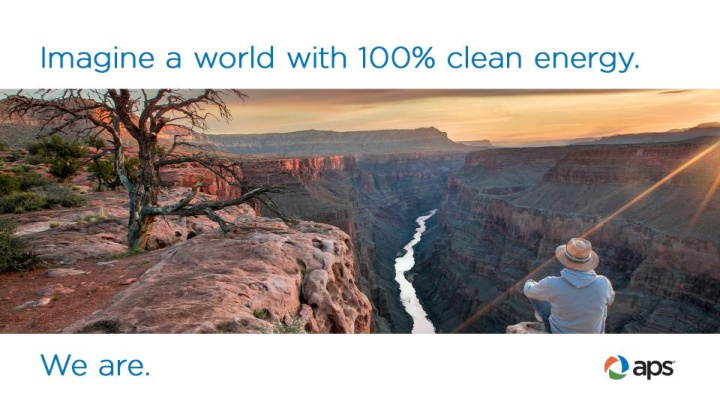



WHO IS APS? 34,646 square mile service territory 11 of 15 counties Arizona’s largest and longest-serving utility Since 1886 1.2 Million Customers Peak energy demand ~7,500 megawatts Investor owned Subject to forms of public control and regulation ~6,300 employees
ALREADY 50% clean Nameplate (MW) Natural Gas 5,233 Owned Resources 3,573 PPAs 1 660 2020 APS Coal 1,357 Resource Diversity Nuclear 1,146 Microgrid 32 Renewables 883 Solar 567 NATURAL GAS Owned Solar 242 Solar PPAs 325 COAL Wind (PPAs) 289 Other (PPAs) 27 NUCLEAR ESS 2 Customer-Based 2,120 Energy Efficiency 1,038 Distributed Energy 1,044 Demand Response 38 TOTAL 10,773 Biomass Biogas Geothermal Solar PV Wind CSP w/ storage or ESS
CLEAN ENERGY COMMITMENT 100% clean, carbon-free electricity to customers by 2050. 2030 target; 65% clean energy using 45% renewables. 2031 retire coal-fired generation.
NOW-2030 CLEAN ENERGY COMMITMENT How we get there: clean, reliable, affordable and customer centric Increase renewable energy Decrease coal Support transition with natural gas Increase energy storage Continued economic growth of Arizona
APS IS A LEADER IN SOLAR POWER 1.5 gigawatts of 107,771 interconnected total solar capacity DG systems Up to 25 percent Innovative distributed Solar storage, solar power in energy projects EV microgrids non-summer months Nationally recognized Solar R&D, Grid modernization, advanced research Storage integration
EXITING COAL: FIRST STEP TO CLEAN Plan to exit coal 7 years earlier than originally Navajo projected 315 MW Cholla 387 MW by 2025 Remaining 970 MW by 2031 Coal Free 2018 2019 2025 2031 7
NATURAL GAS: KEY TO THE TRANSITION Energy in GWH 30000 25000 Renewables 20000 15000 Natural Gas 10000 Coal 5000 0 2020 All Plans Bridge (2035) Shift (2035) Accelerate (2035) Source: 2020 IRP, Pg. 136 & 138
ENERGY STORAGE: ESSENTIAL TO FUTURE OF CLEAN
ECONOMIC GROWTH: ENABLES SUCCESS Constructive engagement with economic development community partners and timely, strategic engagement with prospects, site • Business attraction & expansion selectors, and local developers Provide financial and strategic economic • Community development development support in both rural and metro communities Advance the entrepreneurial ecosystem by • Entrepreneurial support supporting organizations that are making an impact, whether through job creation, capital raised, education or quality programming • Infrastructure support Drive commercial real estate development by working closely with developers and the Arizona State Land Department to make large commercial land parcels “shovel ready”
PATHWAYS TO 100% CLEAN ENERGY Support policy decisions that leverage market-based Policy Decisions technology and innovation to attract investment in Arizona Near-term use of natural gas until technological advances Existing Power Sources are available to maintain reliable service at reasonable prices Participation in the Energy Imbalance Market provides access Evolving Market-Based Solutions to clean energy resources while saving customers money Electrification will drive a cleaner environment and more Electrification energy-efficient operations throughout the economy Continue to advance infrastructure that is responsive and Modernization of the Electric Grid resilient while providing customers more choice and control Storage creates opportunity to take advantage of midday Energy Storage Solutions solar generation and better respond to peak demand
2030 – 2050 RESEARCH & DEVELOPMENT How we get there: clean, reliable, affordable and customer centric Long duration storage Push innovation and partnership Future technology
STORAGE SOLUTIONS: HYDROGEN Palo Verde collaborates on a pilot project to explore the production of hydrogen at Palo Verde Generating Station Idaho Xcel Energy Palo Verde National Harbor Energy Laboratory • The pilot program will examine the long-term cost-effectiveness of hydrogen production at utility scale and is expected to run from 2020 to 2022. • Idaho National Laboratory will prepare technical & economic feasibility assessment. The assessment will consider regional power prices in order to determine the cost-effectiveness of producing hydrogen using Palo Verde Generating Station electricity. • APS will look at the technical feasibility of electrolysis, a method that splits water into oxygen and hydrogen, and the cost of equipment, principally the electrolyzer. 13
PUSH PARTNERSHIP AND INNOVATION AZ Clean Energy Future APS and Advanced Energy Economy co-led a unique process to engage businesses to work collaboratively to find product, service and business solution opportunities to address challenges with integrating more clean energy. Project Participants
FUTURE TECHNOLOGY Through our parent company, Pinnacle West, we are investing in the transition to a cleaner, more reliable and customer-friendly energy ecosystem InvisionAz fund will provide venture capital to Arizona tech start-ups allowing them to scale here. Energy Impact Partners funds transformative technologies that will be building blocks for the energy infrastructure of the future
Recommend
More recommend